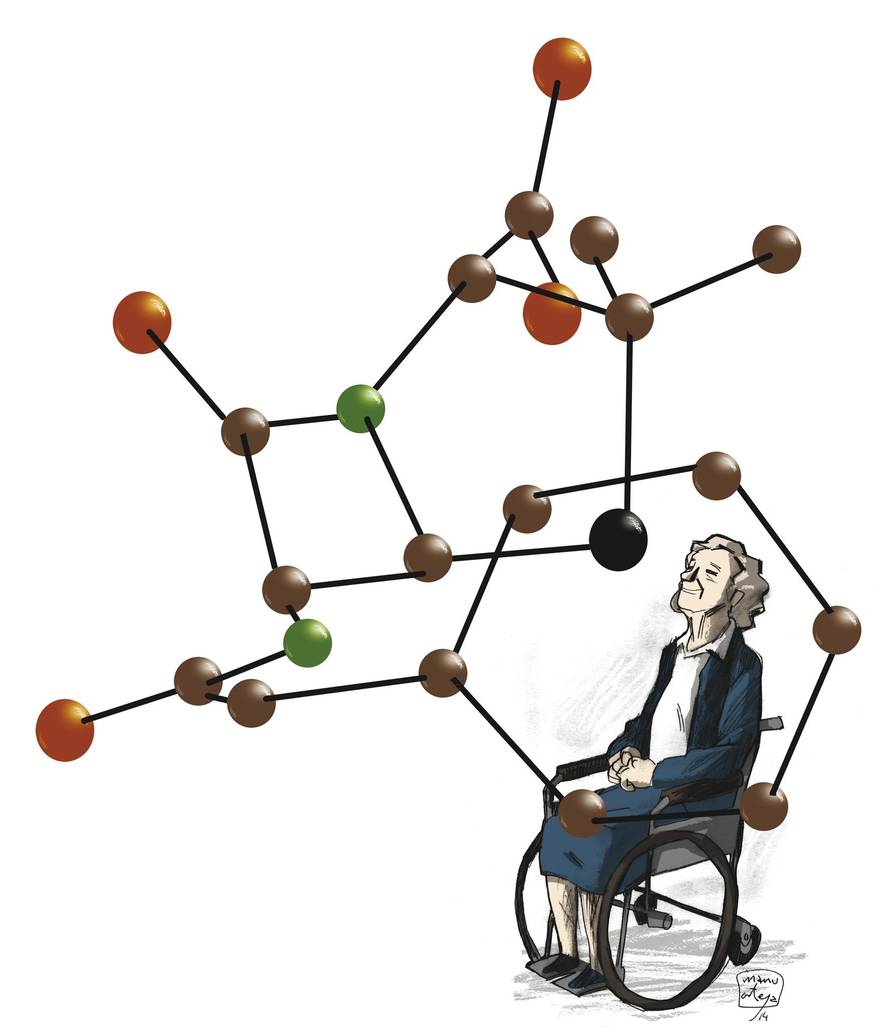Dorothy Crowfoot, leader in crystallography on social norms
The photos Franklin brought to him seemed wonderful. These are DNA images taken with X-rays. They opened on a large laboratory table and Franklin explained that he had three options for the structure of DNA. "But Rosalind, these two are impossible!" He threw him. Franklin did not understand why, but he knew that the words of Dorothy Crowfoot Hodgkin were worthy to take into account; he would hardly find more crystallography of biological molecules.
Dorothy Crowfoot was born in Cairo in 1910. His parents were English and he spent his first years of life between Cairo and England. Convinced that gender should not be an obstacle, parents always encouraged the hobbies of their four daughters, Dorothy, the oldest. They soon discovered Dorothy's. When they started working chemistry at school, during a session, the crystals grew, Dorothy was fascinated and his parents allowed him to create a laboratory to continue growing the crystals in his house chamber. Her mother, in addition, broke her daughter's hobby. For example, he bought a couple of books by William Lawrence Bragg. They read them together and were delighted: With X-rays you could see the atoms in the crystals!
He studied chemistry at the Somerville faculty of the University of Oxford and at the time when he had to decide what to do for the research project, installed a new X-ray crystallography laboratory at the university. Since reading Bragg, Crowfootek had in mind the idea of seeing atoms in crystals, and so, at the University of Oxford, Crowfooten did his first work on the structure of crystals on the salts of thallium (published in Nature in 1931).
He then went to Cambridge for a doctorate with the prestigious John Desmond Bernal. Bernal took women and men alike in his laboratory and, upon learning of the virtues of Crowfoots, he accepted with satisfaction. Together they showed that X-ray crystallography also serves to know the structure of biological molecules and took in 1934 the first photos of crystals of a protein (pepsin).
That same year, Crowfoot returned to Oxford. In fact, in the faculty of Somerville he was offered a job with the possibility of directing his laboratory. Shortly afterwards he married Thomas Hodgkin and then he was his mother. He had three children. When his first child was born, his sister said: "Now what do you prefer, son or Somerville? ". However, Crowfoots did not see the need to choose, he married and although he was a mother he did not intend to leave his job. "Don't you understand it? I need to know!"
For several years he investigated the structure of the sterols and in 1945 clarified the structure of penicillin. It was a great discovery, followed by another: Structure of vitamin B12. Being able to know the structures of these complex molecules was a very important step for crystallography.
Meanwhile, the father of crystallography, William Lawrence Bragg, discovered that the path undertaken by Bernal and Crowfoots had a great future, and it was in it that the researcher of the laboratory Cavendish, who had just directed, investigated the crystallography of biological molecules. In April 1953, Crowfoot Cavendish visited the first fruits of the Braggen group: James Watson and Francis Crick clarified the structure of DNA thanks to data from Rosalind Franklin.
In 1959, two other researchers from the Braggen group, Max Perutz and John Kendrew, clarified the structures of hemoglobin and myoglobin proteins. In 1962 the Novel of Medicine and Physiology was awarded to Watson and Crick, and that of Physics to Perutzi and Kendrew. Perutze publicly acknowledged his shame: "I was embarrassed when I learned that I was given the Nobel Prize before Dorothy, because her great discoveries are made with such skill and chemical rigor, and before mine." He proposed that he would be given the Crowfooti Novel and Bragg himself. He was given two years later, in 1964.
"A British woman has won the Nobel Prize. Daily Telegraph announced that "the prize is 18.70 for the mother of the three children." "An Oxford housewife has won the Novel," from Daily Mail; and "the Nobel prize is a grandmother," from New York Times.
Fortunately, his colleagues had much more respect than journalists. In this sense, she had a different fate than that of most women of the time, and being a woman in her career did not complicate things. From his parents, tutors, superiors, husband and co-workers respected him and helped him, as Crowfoots himself acknowledged.
He also kept the surname. After marriage, he continued to sign his work by name and surname for 12 years. She was then asked to use her husband's surname, Hodgkin. Since then he used Dorothy Crowfoot Hodgkin.
After winning the novel, one of his great discoveries came: the structure of insulin. He had to wait many years to get there. He began working for the first time with insulin in 1934, but the molecule was too complex for the technique of the time. However, Crowfoots did not resign and 35 years later, in 1969, he finally managed to clarify the structure of insulin.
"He did his Christalographic research not to seek honor, but because it was what he wanted to do," wrote Max Perutzek. I had such a magic. He had no enemies, nor among those who destroyed his scientific theories, nor among those who had a contrary political tendency. In the same way that his X-ray camera showed the beauty under the rough surface of things, his tenderness to approach the public made him appear in any, even in the most demanding scientist, some ray of goodness."






